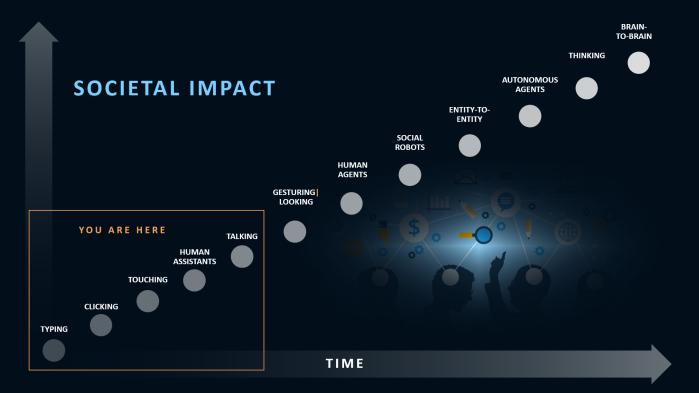Back in 2013, as Smartphone use was growing, I wrote about Next Generation Experiences; viewing customer experience through a lens of constant change, where failure to address foundational elements meant falling further behind. Since then, our mode of interaction witnessed a third transformation, as touch became a critical piece of our everyday experiences. Now, we find ourselves approaching the next significant change in interaction paradigms: the Fourth Transformation driven by mixed reality.

Somewhere in the not too distant future, we will witness a fifth transformation driven by our brainwaves. Here is a brief description of each transformation:
First transformation: typing in the mainframe era. In the 1970s, people typed on a keyboard and used text characters to communicate directly with computers.
Second transformation: clicking in the GUI and Internet era. The graphical user interface (GUI) was born, as Apple introduced the Macintosh in 1984, followed a few years later by Microsoft Windows. We added clicking with a mouse to our modes of interaction.
Third transformation: touching in the smartphone era. The third transformation came in 2007 with the introduction of smartphones. Touch transformed personal computing and became the primary interface.
Fourth transformation: conversational, gesturing, and eye interaction in the mixed reality era. In this era, people will interact by tapping, winking, blinking, talking, and gesturing their way through interactions. An evolution towards eye-based interaction seems inevitable, as technology ultimately understands intent and our eyes drive action without gesture or voice cues.
As more learning and innovation happens in the area of brain science, a fifth transformation will occur: brain interaction in the brainwave era. We have already reached a point where people playing games in headsets move things around and zap zombies with brainwaves rather than hand controls.
With each transformation, experience speeds up and the ease in which we accomplish things is enhanced. This transformation in interaction combined with the emergence of ecosystems will change the way we experience life in considerable ways. I’ll focus on the ecosystem piece of this evolution in my next post.

In the Fourth Transformation people will see computer generated images mixed tightly with reality where we won’t really be able to tell what is real and what is illusion. What is the business advantage of that?
LikeLiked by 1 person
[…] my previous post on the Transformation of Interaction, I mentioned the emergence of ecosystems and their likely impact on how we experience life. […]
LikeLike
[…] The Transformation of Interaction […]
LikeLike
[…] shift the experience end game; specifically, the evolution of Ecosystems and the transformation of Interaction. These two forces – themselves the result of combinatorial innovation – are converging. While […]
LikeLike
I would expect that not only does the transformation become more rapid, speed and accuracy of interpretation of the interaction accelerates significantly. For example a mobile app interpreting my intent to zoom on a specific portion of a photograph is much faster and more precise than how I previously updated zoom percentage and centering coordinates. The Fourth Generation likely ushers in even greater speed and accuracy while expanding the ability to handle much larger and disparate information sets and interpret more subtle contextual variations.
LikeLike
[…] recent post on the transformation of interaction, I talked about the changing ways in which we interact with our machines and each other. These […]
LikeLike
[…] near term application in retail, games, sports, and other. As it progresses, the way we interact transforms slowly – and then suddenly. This is a great example of a building block on the science and […]
LikeLike
[…] Shifting interaction paradigm: Google recently unveiled a new AI assistant that can talk and interact like a person. When Duplex called a hair salon to make an appointment, the woman on the line had no idea she wasn’t talking to a person. Google says it is building Duplex “to sound natural, to make the conversation experience comfortable.” I have written extensively about the Transformation of Interaction. […]
LikeLike
[…] difficult with our current data input rate; input is slow when the input mechanism is our thumbs. The way we Interact is already transforming, as voice commands makes input faster. A deeper transformation is within […]
LikeLike
[…] are combining to drive this trend. This is simply the start of a complete transformation in how we Interact as Humans. This fourth transformation of interaction is driven by mixed reality. A fifth transformation will […]
LikeLike
[…] 2017, I explored the various ways that human interaction was likely to change. Two years later, I shared predictions from Ray Kurzweil that included his thoughts on interacting […]
LikeLike
[…] paradigm shift. The three components of this emerging GPTP in his estimation are the Internet (communication), renewable energy (Energy), autonomous vehicles and the Internet of Things (Logistics and […]
LikeLike
[…] have been several waves of change to our interaction paradigm through at least three stages of transformation. However, the next transformation will alter many long-standing beliefs, and as we explore […]
LikeLike